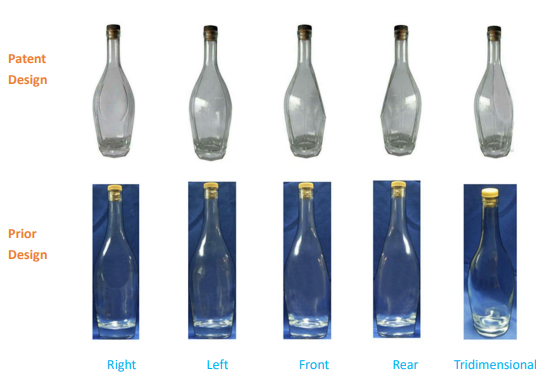Factoring In Design Space In Ascertaining Similarity Of Designs (2020)
ZHAO Hewen
Article 23 of China’s Patent Law provides that a design for which a patent is granted shall significantly differ from prior design. The provision bars any design substantially similar to prior design from being patented. The similarity between a design patent and a prior design is ascertained from the perspective of ordinary consumer in respect of the specific category of product incorporating the design patent.
The following steps are to be taken in ascertaining similarity of designs: 1) observation will be made to identify all the similarities and differences between the design patent and prior design; 2) the identified differences will be assessed so as to ascertain whether such differences notably influence the overall visual effect of the patent product, making the design patent significantly different from the prior design, thus meeting the patentability requirement.
Given that the above steps are to be taken on the basis of ordinary consumer perception, it is therefore crucial to identify the knowledge and cognitive capability of ordinary consumer, which China’s Supreme People's Court (SPC), resorts to certain parameters, inter alia “design space”, to ascertain. The Court, for the first time, defines, in a retrial ruling concerning the administrative suit over an invalidation decision of a design patent [(2010) Supreme Court Retrial Administrative Judgment No.5], design space as the leeway a designer has when creating specific design for a product. It is not until the promulgation of the Interpretation (II) of the Supreme People's Court on Several Issues concerning the Application of Law in the Trial of Patent Infringement Dispute Cases, which came into force on April 1, 2016, that the Court formally introduces the concept “design space” in the legislation. Article 14 of the SPC Interpretation provides that “A people's court shall, when determining an ordinary consumer's knowledge and cognitive capability in terms of the design, take into account the design space of the products of the same or similar category in terms of the patented design, at the time when the alleged infringing act occurs. Where there is much design space, the people's court may determine that in general an ordinary consumer is unlikely to notice the minor differences between different designs. Where there is not much design space, the people's court may determine that in general an ordinary consumer is likely to notice the minor differences between different designs”. In plain English, if the product category has big design space, the difference between the design patent and prior design has a relatively small impact on the overall visual appearance, making the design patent substantially similar to the prior design and thus unpatentable.
This article will analyze the application of the aforesaid provisions in a recent design patent administrative suit.
Martell Corp. initiated an invalidation administrative proceeding against a design patent ZL201430195369.1 titled “wine bottle”, which is owned by a Chinese natural person surnamed HUANG. In the first instance proceeding, the Beijing IP Court found that the patent is not significantly different from the prior design, revoking the invalidation decision in favor of the patentee.

The patent design and prior design share the following features: (1) both are hyaline glass bottle comprising bottle stopper, bottle mouth, bottle neck and bottle body; (2) The stopper, bottle mouth, bottle neck are of the same shape; (3) The bottle body has in its frontpart an oblique plane extending from the bottle neck all the way down to the middle and lower part of the bottle body, and the shapes of the oblique planes are almost identical.
The differences between the two designs mainly lies in: (1) The shapes of the bottle bodies are different, the bottle body of the patent design has vertical ridges, however, the bottle body of prior design is a smooth curved surface except for the oblique plane; (2) The bottom of the patent design is a regular octagon, but the bottom of the prior art is a circle.
The patent design and the prior design are both designs of bottle, mainly used to contain liquid for storage, transportation and sale. Other than meeting the basic function, there is still considerate design space left for the shape of bottle. In particular, the wine bottles, including those brandy bottles incorporating the patent design, which are actually used by the patentee, are of various shapes, styles and colors.
In light of the considerable design space of products, the court of first instance found that the aforesaid differences would be unlikely to significantly influence the overall visual appearance of the product, based on the reasons that (1) multiple vertical ridges on the bottle body can be clearly shown only in the top and bottom perspective views, but not from other perspectives, thus the difference does not produce a notable visual effect in comparison with the turning surface of prior design; (2) it is highly unlikely that an ordinary consumer would pay attention to the bottom of the bottle during use, and the bottom of the bottle does not produce a noticeable visual effect for an ordinary consumer.
The court therefore concluded that the design patent, which is not significantly different from the prior design, is unpatentable.
Factoring in design space in ascertaining the similarity of designs could help improve the objectivity of the conclusion. In fact, the SPC proposes, in the Provisions of the Supreme People's Court on Several Issues in the Trial of Administrative Cases involving Granting and Affirmation of Patent (Draft), to refer to the following parameters for the assessment of design space: (1) the function and use of product; (2) the design density of prior designs; (3) conventional designs; (4) the imperative provisions of any laws or administrative regulations; and (5) the national or industry technology standards. The draft, which had been released for one-month public comments starting on June 1, 2018, is still in the pipeline. It remains to be seen how these parameters are to be finalized in the final text.



